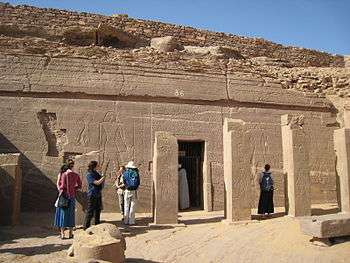Qubbet el-Hawa
Qubbet el-Hawa is a site on the western bank of the Nile, opposite Aswan. The name is derived from the dome of the tomb of an Islamic sheikh, but archaeologically, it is usually understood as referring to the site of the tombs of the officials lined up on artificial terraces below the summit of the Nile bank upon which the Islamic tomb stands.

Ancient Egyptian site - so called Tombs of Nobles
The elite Tombs date mainly from the Old Kingdom and provide an insight into the burial traditions of Upper Egyptian Nome 1 during the later Old Kingdom. The tombs include the famous tomb of Harkhuf. Others belong to Sabni, Ishemai or Heqaib. There are also some later tombs, from the Middle Kingdom and New Kingdom. Among the most important tombs are those of the expedition leaders (like Harkhuf) despatched to distant lands to negotiate the acquisition of foreign goods for the Egyptian court. During the Middle Kingdom, a minor sanctuary for one (or more) of these leaders (designated with the appelation "Heqa-jb") was prominent in the town at Elephantine. Excavation work continues.
Coptic site
The hill is also the site of a Coptic monastery of Saint Anthony[1] and some of the tombs were reused as a Coptic church.
Bibliography
- Elmar Edel (edited by Karl-J. Seyfried, Gerd Vieler): Die Felsgräbernekropole der Qubbet el-Hawa bei Assuan. I. Abteilung. (Band 1-3, Pläne und Tafeln). Architektur, Darstellungen, Texte, archäologischer Befund und Funde der Gräber QH 24 - QH 209. Verlag Ferdinand Schöningh, Paderborn, 2008. ISBN 978-3-506-76343-3.
- Elmar Edel: Die Felsengräber der Qubbet el-Hawa bei Assuan. Wiesbaden 1967-1971.
- Elmar Edel: Die Reiseberichte des Harchuf (Hrw-hwff) in seinem Grab am Qubbet el-Hawa (34n). Berlin 1955.
- Elmar Edel: Beiträge zu den Inschriften des Mittleren Reiches in den Gräbern der Qubbet el-Hawa. Berlin 1971.
- Elmar Edel: Altägyptische Fürstengräber bei Assuan. Ausgrabungen auf der Qubbet el-Hawa. Berlin 1966.
- Alan Gardiner: Egypt of the Pharaohs. Oxford 1961.
- Labib Habachi: 16 Studies on lower Nubia. In: Annales du services des Antiquities de l'Egypte. (ASAE) Nr. 23, 1981.
- Labib Habachi: The Sanctuary of Heqaib. Mainz 1985.
- Michael Höveler-Müller: Funde aus dem Grab 88 der Qubbet el-Hawa bei Assuan. (Die Bonner Bestände), Wiesbaden 2006.
- M. R. Jenkins: Notes on the Tomb of Setka at Qubbett el-Hawa, Aswan. In: Bulletin of the Australian Center for Egyptology. (BACE) Bd. 11, Sydney 1999 S. 67–81.
- Jacques de Morgan: Catalogue des monuments et inscriptions de l’Egypte antique. Wien 1894.
- Hans Wolfgang Müller: Die Felsengräber der Fürsten von Elephantine aus der Zeit des Mittleren Reiches. Glückstadt 1940.
- Friedrich Wilhelm Rösing: Qubbet el-Hawa und Elephantine. Zur Bevölkerungsgeschichte von Ägypten. Fischer, Stuttgart/ New York 1990, ISBN 3-437-50325-1.
- Kurt Sethe, Urkunden des Alten Reiches. , Abteilung I, Band I, Heft 1-4, Leipzig 1932-3.
References
- Timm, Stefan (1984). Das christlich-koptische Agypten in arabischer Zeit. Wiesbaden. p. 234.
External links
| Wikimedia Commons has media related to |